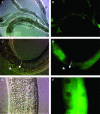The CRAL/TRIO and GOLD domain protein CGR-1 promotes induction of vulval cell fates in Caenorhabditis elegans and interacts genetically with the Ras signaling pathway
- PMID: 16219793
- PMCID: PMC1456255
- DOI: 10.1534/genetics.104.035550
The CRAL/TRIO and GOLD domain protein CGR-1 promotes induction of vulval cell fates in Caenorhabditis elegans and interacts genetically with the Ras signaling pathway
Abstract
Ras-mediated signaling is necessary for the induction of vulval cell fates during Caenorhabditis elegans development. We identified cgr-1 by screening for suppressors of the ectopic vulval cell fates caused by a gain-of-function mutation of the let-60 ras gene. Analysis of two cgr-1 loss-of-function mutations indicates that cgr-1 positively regulates induction of vulval cell fates. cgr-1 is likely to function at a step in the Ras signaling pathway that is downstream of let-60, which encodes Ras, and upstream of lin-1, which encodes a transcription factor, if these genes function in a linear signaling pathway. These genetic studies are also consistent with the model that cgr-1 functions in a parallel pathway that promotes vulval cell fates. Localized expression studies suggest that cgr-1 functions cell autonomously to affect vulval cell fates. cgr-1 also functions early in development, since cgr-1 is necessary for larval viability. CGR-1 contains a CRAL/TRIO domain likely to bind a small hydrophobic ligand and a GOLD domain that may mediate interactions with proteins. A bioinformatic analysis revealed that there is a conserved family of CRAL/TRIO and GOLD domain-containing proteins that includes members from vertebrates and Drosophila. The analysis of cgr-1 identifies a novel in vivo function for a member of this family and a potential new regulator of Ras-mediated signaling.
Figures




Similar articles
-
lin-1 has both positive and negative functions in specifying multiple cell fates induced by Ras/MAP kinase signaling in C. elegans.Dev Biol. 2005 Oct 1;286(1):338-51. doi: 10.1016/j.ydbio.2005.08.007. Dev Biol. 2005. PMID: 16140291
-
Activation of Wnt signaling bypasses the requirement for RTK/Ras signaling during C. elegans vulval induction.Genes Dev. 2002 May 15;16(10):1281-90. doi: 10.1101/gad.981602. Genes Dev. 2002. PMID: 12023306 Free PMC article.
-
ced-10 Rac and mig-2 function redundantly and act with unc-73 trio to control the orientation of vulval cell divisions and migrations in Caenorhabditis elegans.Dev Biol. 2002 Jan 15;241(2):339-48. doi: 10.1006/dbio.2001.0513. Dev Biol. 2002. PMID: 11784116
-
LET-23-mediated signal transduction during Caenorhabditis elegans development.Mol Reprod Dev. 1995 Dec;42(4):523-8. doi: 10.1002/mrd.1080420422. Mol Reprod Dev. 1995. PMID: 8607985 Review.
-
Ras proteins in developmental pattern formation in Caenorhabditis elegans and Drosophila.Semin Cancer Biol. 1992 Aug;3(4):219-28. Semin Cancer Biol. 1992. PMID: 1421166 Review.
Cited by
-
The CRAL/TRIO and GOLD domain protein TAP-1 regulates RAF-1 activation.Dev Biol. 2010 May 15;341(2):464-71. doi: 10.1016/j.ydbio.2010.03.003. Epub 2010 Mar 15. Dev Biol. 2010. PMID: 20230813 Free PMC article.
-
Canonical RTK-Ras-ERK signaling and related alternative pathways.WormBook. 2013 Jul 11:1-38. doi: 10.1895/wormbook.1.80.2. WormBook. 2013. PMID: 23908058 Free PMC article. Review.
-
Identification of mutations in Caenorhabditis elegans that cause resistance to high levels of dietary zinc and analysis using a genomewide map of single nucleotide polymorphisms scored by pyrosequencing.Genetics. 2008 Jun;179(2):811-28. doi: 10.1534/genetics.107.084384. Epub 2008 May 27. Genetics. 2008. PMID: 18505880 Free PMC article.
-
Functional distinction in oncogenic Ras variant activity in Caenorhabditis elegans.Dis Model Mech. 2024 Aug 1;17(8):dmm050577. doi: 10.1242/dmm.050577. Epub 2024 Aug 14. Dis Model Mech. 2024. PMID: 38946472 Free PMC article.
References
-
- Aamodt, E. J., M. A. Chung and J. D. McGhee, 1991. Spatial control of gut-specific gene expression during Caenorhabditis elegans development. Science 252: 579–582. - PubMed
-
- Barbacid, M., 1987. ras genes. Annu. Rev. Biochem. 56: 779–827. - PubMed
-
- Beitel, G. J., S. G. Clark and H. R. Horvitz, 1990. Caenorhabditis elegans ras gene let-60 acts as a switch in the pathway of vulval induction. Nature 348: 503–509. - PubMed
Publication types
MeSH terms
Substances
LinkOut - more resources
Full Text Sources
Molecular Biology Databases

